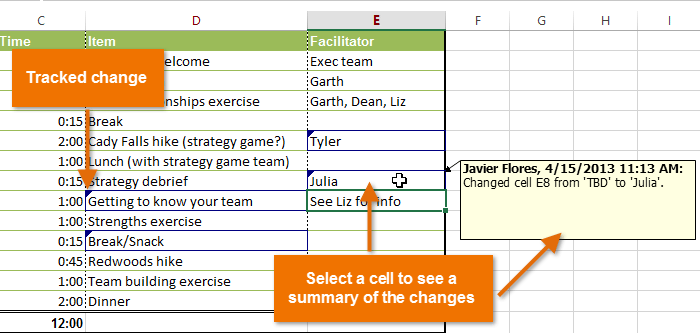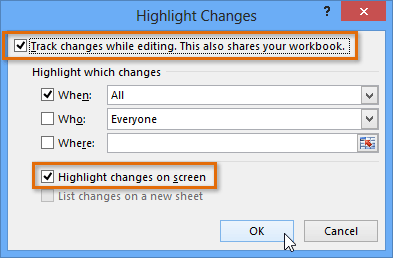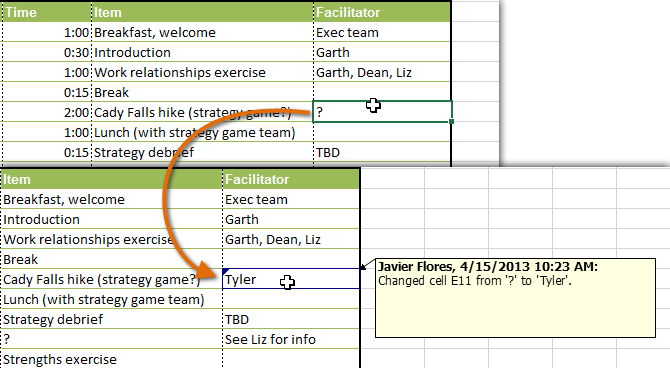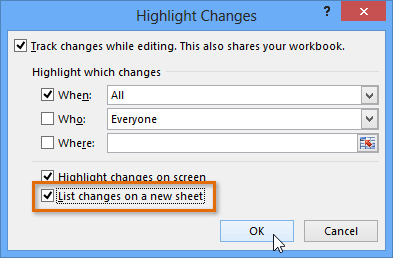Excel 2013
Track Changes and Comments
Introduction
Suppose someone asked you to proofread or collaborate on a workbook. If you had a printed copy, you might use a red pen to edit cell data, mark spelling errors, or add comments in the margins. Excel allows you to do all of these things electronically using the Track Changes and Comments features.
Optional: Download our Lesson 24 Practice Workbook.
Understanding Track Changes
When you turn on the Track Changes feature, every cell you edit will be highlighted with a unique border and indicator. Selecting a marked cell will show the details of the change. This allows you and other reviewers to see what's been changed before accepting the revisions permanently.
 A worksheet with tracked changes
A worksheet with tracked changesThere are some changes Excel cannot track. Before using this feature, you may want to review Microsoft's list of changes that Excel does not track or highlight.
You cannot use Track Changes if your workbook includes tables. To remove a table, select it, click the Design tab, then click Convert to Range.
To turn on Track Changes:
- From the Review tab, click the Track Changes command, then select Highlight Changes... from the drop-down menu.
 Selecting Highlight Changes...
Selecting Highlight Changes... - The Highlight Changes dialog box will appear. Check the box next to Track changes while editing. Verify the box is checked for Highlight changes on screen, then click OK.
 Turning on Track Changes
Turning on Track Changes - If prompted, click OK to allow Excel to save your workbook.
 Clicking OK to save the workbook
Clicking OK to save the workbook - Track Changes will be turned on. A triangle and border color will appear in any cell you edit. If there are multiple reviewers, each person will be assigned a different color.
- Select the edited cell to see a summary of the tracked changes. In our example below, we've changed the content of cell E11 from "?" to "Tyler".
 Using the Track Changes feature
Using the Track Changes feature
When you turn on Track Changes, your workbook will be "shared" automatically. Shared workbooks are designed to be stored where other users can access and edit the workbook at the same time, such as a network. However, you can also track changes in a local or personal copy, as seen throughout this lesson.
To list changes on a separate worksheet:
You can also view changes on a new worksheet, sometimes called the Tracked Changes history. The history lists everything in your worksheet that has been changed, including the "old value" (previous cell content) and the "new value" (current cell content).
- Save your workbook.
- From the Review tab, click the Track Changes command, then select Highlight Changes... from the drop-down menu.
 Selecting Highlight Changes...
Selecting Highlight Changes... - The Highlight Changes dialog box will appear. Check the box next to List changes on a new sheet, then click OK.
 Listing changes on a new worksheet and clicking OK
Listing changes on a new worksheet and clicking OK - The tracked changes will be listed on their own worksheet, called History.
 A summary of all changes on their own worksheet
A summary of all changes on their own worksheet
To remove the History worksheet from your workbook, you can either save your workbook again or uncheck the box next to List changes on a new sheet in the Highlight Changes dialog box.







